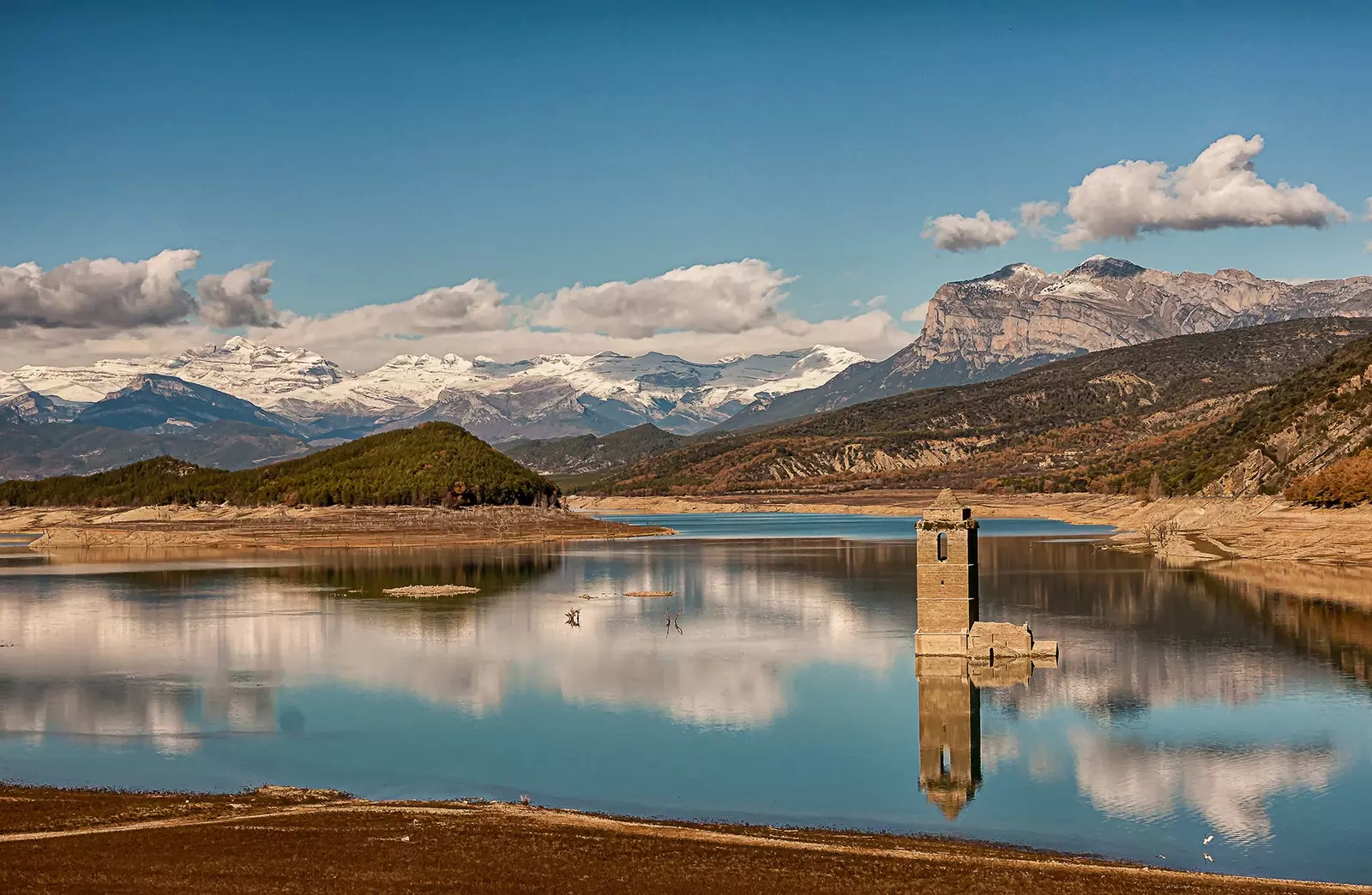
What the reservoir took: submerged Spanish towns
ANDALUSIA
ROMAN SETTLEMENT, HUELVA. Unlike other flooding, in this case the hand of man has had almost nothing to do with it, because everything points to the fact that this city, which dates back to Roman times, was buried over the centuries due to tidal waves and natural erosion . It is one of the most important underwater deposits in Andalusia and, although work is being done on its protection and recovery, not visible to the naked eye . It is located under the waters of the Carreras river, between Ayamonte and Isla Cristina , where Roman remains have been found such as amphorae, ceramics, marble, fragments of large columns and human remains dating from the 1st to the 16th century.
PEÑARRUBIA, MALAGA. The 1,800 inhabitants of this town that historically belonged to the Condado del Teba, they were evicted in 1971 to build the Teba reservoir ; their houses were deliberately demolished to prevent their recovery, leaving only the church, the school and the Civil Guard barracks standing; although some time later the water from the reservoir would eventually flood everything. In times of drought it is possible to see the remains of the church and the village cemetery.
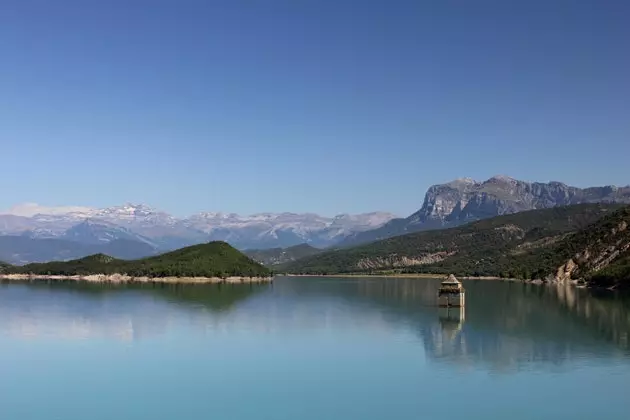
The bell tower of Mediano in the middle of the reservoir
ARAGON
MEDIUM, HUESCA . It is easy to distinguish the Bell tower of the Romanesque church of Mediano - the only building left standing after the flood in 1974 - even in times of greater volume of the waters of the reservoir, because the bell tower protrudes above the water level. It is one of the largest reservoirs in Aragon, and has become a unique diving spot . The curious thing is that until recently it has been possible to dive inside the church, but currently its entrance has been walled up and it is only possible to dive around it from the outside.
ESCÓ, ZARAGOZA. Escó is **an 'almost' ghost town since the 1960s ** due to the construction of the Yesa swamp ; suffered the same fate as the towns of Tiermas and Ruesta evicted for the same reason. But what is striking is that in reality Escó is not a submerged town: all its buildings are on the surface because the water did not reach them, but it did flooded their orchards, their main livelihood , which caused the departure of all its inhabitants. All… except three: three shepherds, the Guallar brothers, who today are reluctant to leave. They continue to live in the town and keep their memory alive, despite the dilapidated appearance of the town. And they are not alone. Not at least for one day a year when old neighbors and other relatives gather there to remember the stories of the past, through the Association for the Reconstruction of Escó.
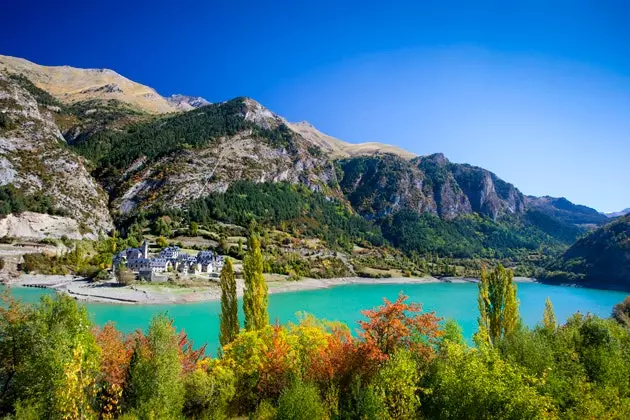
Lanuza, Huesca: an isolated town (cultureta) in the Pyrenees
LANUZA, HUESCA . The history of this town is curious. Despite the flood today it is a picturesque tourist enclave within the Tena Valley , in addition to being the place chosen to celebrate the International Festival of Cultures 'Pirineos Sur'. All because the former inhabitants, who were forced to vacate the area in 1978 by the construction of the Lanuza reservoir , began a revitalization process in the 90s to recover the constructions and buildings that miraculously had not been buried under the waters and who were being victims of looting, as was the case with the church of El Salvador, built in the 19th century on top of a previous Romanesque temple that was burned down in the War of Independence and of which a Chrismon is still preserved on the cover. A church that, by the way, is open to the public and worship.
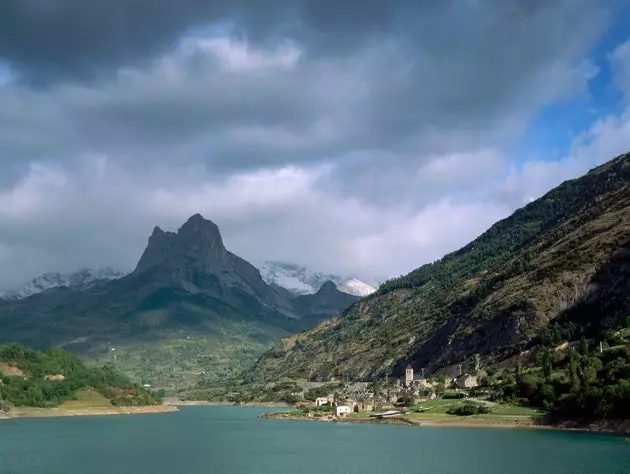
Lanuza is lost in the middle of the Tena Valley
CANTABRIA
THE ROZAS OF VALDEARROYO . It is one of the least populated municipalities in all of Cantabria, and the fault lies with the construction of the Ebro reservoir in the 50s , responsible for the fact that two thirds of its extension were submerged under water -along with the populations of Medianedo, La Magdalena, Quintanilla and Quintanilla de Bustamante -. Waters that reached the surviving church of San Roque, in Villanueva, which is still standing today, despite the fact that the water reaches almost to the bell tower. It can be accessed by a wooden walkway and even ascend inside through a spiral staircase. She is known as "the cathedral of fishes" and it is an enclave of great ecological importance, declared a National Waterfowl Refuge in 1983, a Special Protection Area for Birds (ZEPA) in 2000, a Site of Community Importance (SCI) and included in the Network of Protected Natural Areas of Cantabria for its ornithological and natural values . Almost nothing.
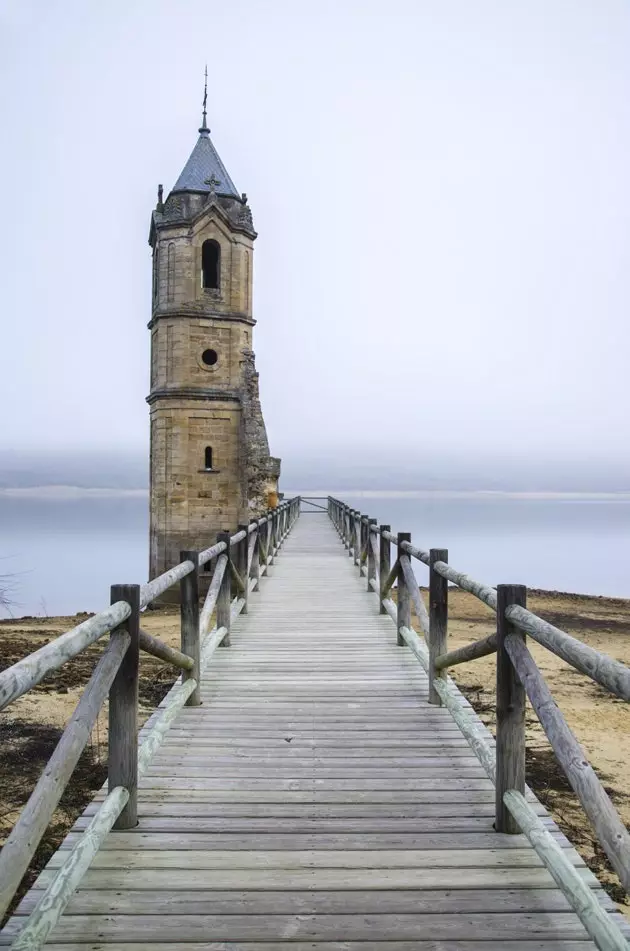
Church of San Roque in Villanueva
CASTILLA LA MANCHA
THE ISABELA, GUADALAJARA. We go back to the 19th century, the time of Fernando VII, who ordered the construction of the Royal Site of La Isabela in a place surrounded by a unique environment with which they say he fell in love: nearby are the remains of the Roman city of Ercávica and at its feet a spring of mineral-medicinal waters that calmed nerves, skin problems and gastrointestinal problems. In 1826 the king ordered to build this royal site, with its palace, its squares, its gardens, its paths and, of course, its spa . They were years of luxury and splendor, until the Civil War came and everything changed: instead of noble families, only the sick came. After this, nobody took care of his recovery and the end of his days came in 1955 with the construction of the Buendía reservoir , whose waters put an end to everything that precisely this area had achieved thanks to them. A story of fame and decline that the journalist Teresa Viejo has investigated in her novel the memory of water.
CASTILE AND LEON
RIBADELAGO, ZAMORA . In the Natural Park of Lake Sanabria, rises the town of Ribadelago, or rather, the two Ribadelago: ‘to Puobro Viello' and ‘to Puobro Nuovo' , as they are known in the area. The explanation of why there are two is as simple as it is tragic: Ribadelago was the victim of the rupture of the dam of Vega del Tera on January 9, 1959, which gave rise to one of the greatest catastrophes caused by a dam. Of the 549 inhabitants that the town had, 144 died and although, despite its dilapidated state, it was not completely abandoned - that's why it still exists today -, the decision was made to build another site in a nearby place. Delfín Rodríguez recounts it in his book 9-E, the night that happened.
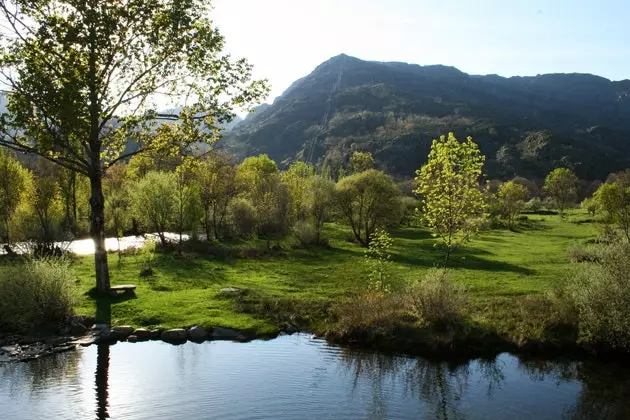
Ribadelago, Zamora submerged
LA MUEDRA, SORIA . The reservoir of Well Rope It is an ideal place to practice water sports in the heart of the Soria province, especially in an area known as Playa Pita, let's say that it is the official beach of Soria . There you can practice numerous sports, including water sports such as windsurfing, sailing, fishing... The surprising thing is that the waters of this place hide a small town, La Muedra, which was flooded by the construction of the reservoir in 1941 . That is why this Cuerda del Pozo reservoir is actually known as the La Muedra reservoir. Quite a tribute.
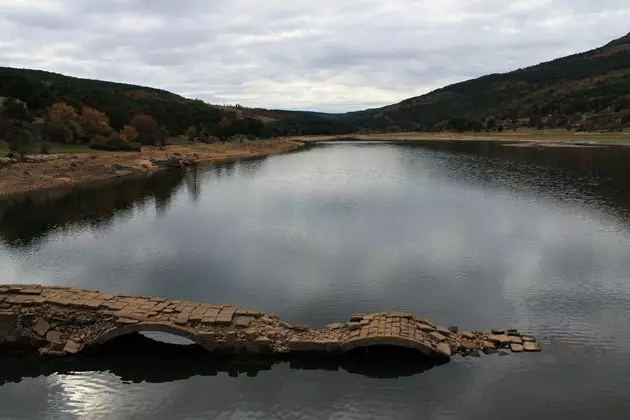
Cuerda del Pozo Reservoir
CATALONIA
SAN ROMAN DE SAU, BARCELONA. In times of drought anyone can walk through its streets and visit some of its buildings , like the church - although with limited access due to the high risk of landslides. But it is not usual, because during the rest of the time San Román de Sau is completely submerged and it is only possible to appreciate the bell tower of its Romanesque church , dated to the eleventh century. The town was flooded in 1962 due to the construction of the Sau reservoir. And the commotion was such that the history of this town gave rise to the shooting of a movie, road cut , filmed in 1955.
SWALLOWED FROM NOGUERA, LLEIDA . Tragó de Noguera was an important and self-sufficient town in the Noguera region. For having, he even had a cinema. But it was not reason enough to leave it standing. The town, which also included the districts of Blancafort, Caños, Boix and Alberola -all except the last one perished under the waters-, was literally swallowed by the Santa Ana reservoir in the 1960s. And today there is nothing but ruins. Only a few remains remain, such as the castle of Tragó, the hermitage of Santa Lucía and the Cistercian monastery of Vallverd, built in 1172. Fun fact: Rosa Mateu Gese was born in the hamlet of Blancafort, great-grandmother of Leo Messi himself.
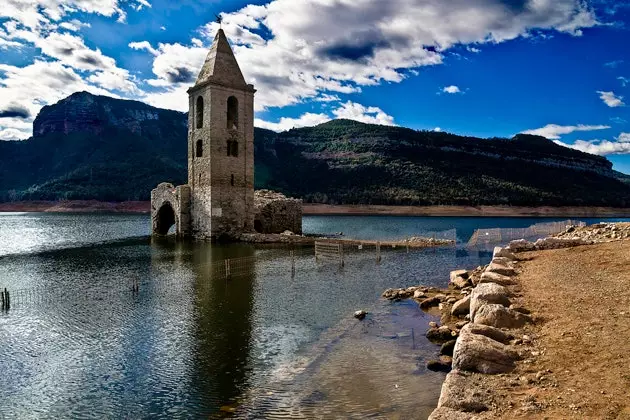
San Roman de Sau in Barcelona
VALENCIAN COMMUNITY
BENAGEBER, VALENCIA . Due to the construction of the reservoir of Benageber , in the 1950s, and the stubbornness of its inhabitants who resisted its disappearance without further ado, today we are talking about three towns with the same name: the Benageber original , buried under the waters of the reservoir; the town they raised about 5 kilometers of this location the inhabitants who were forced to abandon their houses; Y the town inhabited by workers in the 1940s (known as Pantano de Benágeber) during the years that the construction lasted; when these ended in 1955, most emigrated, but not all, because the 2012 census says that 13 people still live there. Another unique fact: part of the population of the original Benágeber moved to other locations, raising two more districts with the Benágeber surname: San Antonio and San Isidro.
TOUS, VALENCIA. The history of this people is linked to suffering. And if not, read: located near the river Júcar, During the 19th century, it suffered several floods due to floods. In the second half of the twentieth in full dam construction boom , Tous was transferred from the Júcar valley to La Ribera, building a new town about 13 kilometers away, due to the construction of the Tous dam; of the old town, that lies completely drowned, only the facade of the church that was taken to the entrance of the new settlement is preserved. And after so much moving, when everyone thought that they were already safe… whoosh! a new disaster: in 1982 the dam collapsed due to torrential rains, causing the largest known flood in Spain. After this bump, the dam was rebuilt with a higher capacity.
ESTREMADURA
TALVAERA THE OLD, CÁCERES. The rampant construction of reservoirs respected neither gray hair nor history. The evidence is in Augustóbriga , an ancient Roman municipality located on one of the banks of the Tagus River, on the road that went from Emerita Augusta (Mérida) to Caesarobriga (Talavera de la Reina). In the Middle Ages it was called Talavera la Vieja, until it disappeared under the waters of the Valdecañas reservoir, built in 1963. But before everything was flooded, the inhabitants dismantled and moved to a nearby location the ruins of an ancient Roman temple, known as 'the marbles' -actually it is the Porch of Curia de Talavera la Vieja, the only one preserved in the entire Roman world-, and three more columns from another temple, 'la Cilla'. Today they are still standing on the banks of the reservoir and are visible from the road from Navalmoral de la Mata to Guadalupe, in the municipality of Bohonal de Ibor.
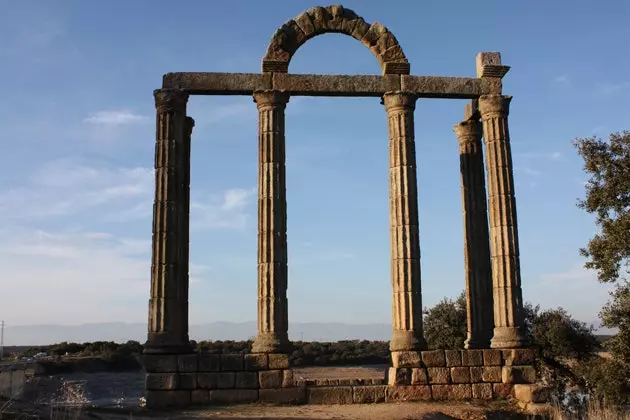
'The Marbles' by Augustóbriga
GRANADILLA, CACERES. Due to the construction of Gabriel y Galán reservoir, Granadilla became an abandoned town, and so it continues to this day. It was evicted and expropriated in the 1960s. And although the water would not finally reach the town, left him almost completely isolated in a peninsula of difficult access , with the orchards and fertile lands completely flooded. But in 1980 it was declared a Historic-Artistic Site and at that precise moment it began its recovery as a town, which lay practically in ruins, restoring its castle, the walls and some houses. Thanks to its inclusion in 1984 in the Interministerial Program of Abandoned Towns , today you can visit its old town and walk through its streets that, although they do not look like they did then, do leave a record of what it was.
GALICIA
ACEREDO, ORENSE. the old little town of Acered or, in the heart of the Xurxés Natural Park (in Lobios), it lies under the waters of the Portuguese reservoir of Lindoso together with four other villages. The striking thing is that its flooding is quite recent , from 1992, although it is the result of an agreement signed in the 1960s. And to everyone's surprise, especially its former neighbors, only two years ago the extreme drop in the dam's flow exposed a good part of the their buildings and belongings: it was possible to see how some houses preserve even the roof and the shutters. If 20 years are nothing.
PORTOMARIN, LUGO . Known today for the quality of its liquor, Portomarín is a town that was born and grew up next to a Roman bridge over the Minho river . He lived there until the Belesar reservoir was built in 1962, forcing his eviction and transfer. When the day of the move arrived, her neighbors did not want to leave anything and took even the church of saint nicholas , in Romanesque style, whose stones were numbered and reassembled in their current location. Nowadays, in times of low level of the swamp, the remains of the old buildings are visible , even those of the primitive Roman bridge.
THE RIOJA
MANSILLA OF THE SIERRA, LA RIOJA. This town was flooded at the end of the 1950s due to the construction of the Mansilla reservoir, in the Najerilla River . That is why the town was moved and raised again in a nearby location. Objects from the old submerged church that today reside in the Church of the Conception, or the bridge of Suso, which was moved stone by stone in the year 2000 from the bottom of the reservoir and rebuilt at the entrance to the town. The rest of the ruins can be seen in the months of September and October, when the waters of the swamp descend considerably.
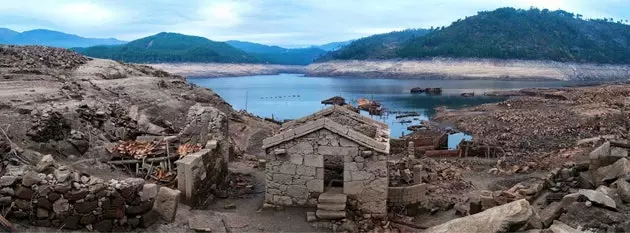
aceredo
